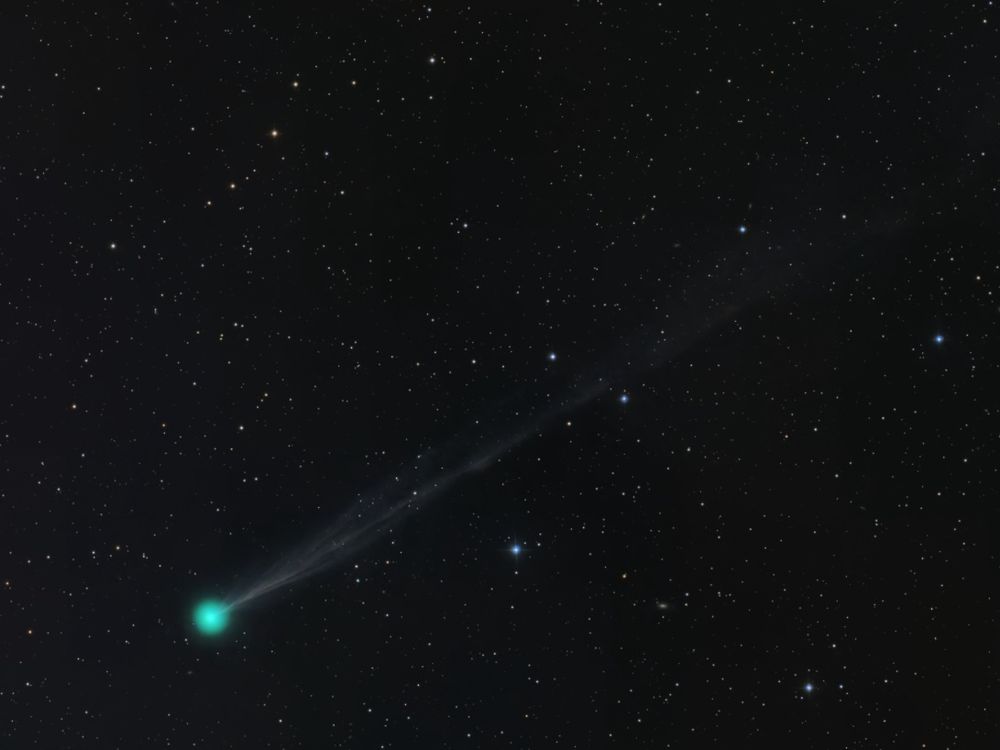A Newly Discovered and Brilliantly Green Comet Is Dazzling Astronomers. Here's What to Know About the Glowing Celestial Visitor
A Newly Discovered and Brilliantly Green Comet Is Dazzling Astronomers. Here’s What to Know About the Glowing Celestial Visitor
Initial observations suggest the comet, called C/2025 F2 (SWAN), will continue getting brighter as it approaches the sun. Northern Hemisphere viewers with binoculars can currently spot it in early morning skies
Comet C/2025 F2 (SWAN) captured from California.
Dan Bartlett
Meet comet C/2025 F2 (SWAN): a celestial body glowing green as it swings around the sun, currently visible in the early morning hours with backyard gear, such as small telescopes or binoculars.
Typically, comets are named for their discoverers, and this one is named after SWAN, a camera aboard the Solar and Heliospheric Observatory (SOHO) spacecraft, which first detected the celestial body. Australian amateur astronomer Michael Mattiazzo noticed the comet in SWAN’s images in late March. According to EarthSky’s Eddie Irizarry, it was also independently discovered by Ukrainian Vladimir Bezugly. Since then, a number of photographers have capturedstunning photographs of the celestial visitor.Comets are bodies of rock, dust and ice left over from the formation of our universe. When they pass close to the sun, comets warm up, giving off a cloud of gas and dust that glows and forms a tail.
“A new comet is always exciting. They appear unexpectedly. They’re quite beautiful. They do tell us a lot, too, about our solar system and about how the planets formed,” Paul Wiegert, an astronomer at the University of Western Ontario in Canada, tells Nicole Mortillaro of the Canadian Broadcasting Corporation (CBC). “So, you know, it’s sort of a beautiful addition to our springtime skies.”
Since its discovery, C/2025 F2 (SWAN) has become brighter as it approaches perihelion—the closest point to the sun in its orbit, which will happen on May 1. If it continues to brighten, the comet might even become visible to the naked eye, as Asa Stahl writes for the Planetary Society. However, Stahl (who is also an astrophysicist) adds that comets’ appearances are “notoriously” difficult to forecast. It remains possible that the comet could break apart when it nears the sun, he adds, but “only time will tell.”
Comet C/2025 F2 (SWAN) on April 9 2025.
Dan Bartlett
“We expect it to get brighter, not because it’s necessarily getting more solar heating and being more active and producing more of the gases that we see, but our geometry relative to it, we’re going to get closer to it,” Wiegert explains to the CBC. “And all of those details are going to work in its favor. So, we’re hoping that it’s going to get quite a bit brighter over the next month or so.”
Every once in a while, a passing comet like this one dazzles skywatchers by glowing a bright green.
“The green coma [the comet’s dusty glow] is the result of diatomic carbon being ejected from the comet’s surface,” astrophotographer Mike Olason writes for Sky & Telescope, describing a photograph he took of the comet. “Sunlight destroys the diatomic carbon in the comet’s coma, which is the reason one never sees a comet with a green tail. Evidently, there is not a lot of dust particles being ejected from the comet’s surface, since the dust tail is not very bright or wide.”Based on his own photograph of the comet, astrophotographer Michael Jäger told Live Science’s Harry Baker earlier this week that C/2025 F2 (SWAN)’s faint tail likely spans two degrees of the night sky—or about twice the width of your pinky finger, held at arm’s length—which is significant given its distance from the sun.
According to Space.com’s Joe Rao, stargazers armed with binoculars or telescopes in the Northern Hemisphere can spot the comet shortly before sunrise along the northeast horizon, through April 25. Afterward, C/2025 F2 (SWAN) will be visible after sunset on the west-northwest horizon, likely disappearing after May 5. The comet should become visible to the Southern Hemisphere around May 4.
Trying to catch a glimpse of this comet could be worth getting up early or staying up late for, if only because it’s a once-in-a-lifetime event—C/2025 F2 (SWAN) orbits the sun once every 1.4 million years, so don’t expect it back any time soon!
Get the latest stories in your inbox every weekday.


